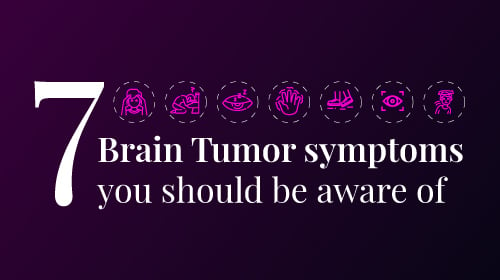Brain Cancer; Symptoms, Causes, and Treatment
September 19, 2022

Overview of Brain Cancer
The development of malignant cells in the brain leads to brain cancer. Depending on the type of tumor, the cancer cells produce slow- or fast-growing tumors depending on the type of tumor.
Brain cancer treatment aims to remove the tumor and eradicate any cancer cells that may still be present. In particular, new advancements in brain cancer therapies are increasing survival rates for slow-growing tumors.
Primary brain cancer, commonly referred to as brain cancer, is characterized by an excess of brain cells that develop into masses known as brain tumors. Cancer, on the other hand, begins in another place of the body and progresses to the brain. It is referred to as secondary or metastasized brain cancer when that occurs.
Some malignant brain tumors have a rapid rate of growth. These cancerous tumors may interfere with how your body functions. Brain tumors should be treated as soon as they are discovered since they can be fatal.
What varieties of brain tumors are there?
Researchers have identified over 150 different types of brain tumors.
Glial (made up of glial cells in your brain) or non-glial (formed on or in the structures of your brain, including nerves, blood arteries, and glands) primary tumors are classified as benign (noncancerous) or malignant by medical professionals (cancerous).
In your spinal column or skull, numerous different types of brain tumors can develop.
Brain Cancer Symptoms
The size and location of the brain tumor affect the symptoms of brain cancer. However, in its early stages, brain cancer exhibits many of the same symptoms as several less dangerous diseases.
Numerous of these symptoms are incredibly typical and are not likely to be signs of brain cancer. However, it’s a good idea to see a doctor if you’ve had any of these symptoms for longer than a week, if they came on suddenly, if they don’t go away with over-the-counter painkillers, or if any of them worry you.
Common brain cancer symptoms include:
- Morning headaches that are typically worse
- Nausea,
- Vomiting,
- Lack of balance,
- Coordination problems
- Difficulty walking
- Forgetfulness
- Difficulties in thinking and speaking
- Vision issues
- Inconsistent eye motions
- Jerks or twitching of the muscles
- Inexplicable fainting
- Drowsiness
- Tingling or numbness in the arms or legs
- Seizures
Brain cancer causes and risk factors
It is unclear what explicitly causes primary brain cancer. However, research has revealed a connection between exposure to high levels of ionizing radiation and a higher chance of developing brain cancer. The most frequent sources of ionizing radiation include radiation therapy treatments, frequent medical imaging tests (CT scans, X-rays), and potential employment exposure.
Additional factors that could increase the risk of acquiring brain cancer include:
- Age
- A family history of brain cancer
- Smoking for a long time,
- Using pesticides, herbicides, fertilizer,
- Working with substances like lead, plastic, rubber, petroleum, and some fabrics can cause cancer.
Some types of cancer are more likely to cause secondary brain cancer than others, which is the kind of brain cancer that develops when cancer travels from another region of your body to your brain.
The following cancers frequently metastasize or spread to the brain:
- Lung disease
- Breast cancer
- Kidney cancer
- Bladder cancer
- Melanoma, a form of skin cancer,
How is cancer of the brain detected?
Your doctor may carry out one of the following procedures to determine whether you have symptoms of a brain tumor:
A brain biopsy, which is a surgical procedure in which a small amount of the tumor is removed for diagnostic testing and to determine whether your tumor is malignant, a neurological examination to determine whether a tumor is affecting your brain imaging tests, such as CT, MRI, and positron emission tomography (PET) scans, to locate the tumor a lumbar puncture, which is a procedure that collects a small sample of the fluid that surrounds your brain and spinal cord, to check
A neurological examination, which includes searching for abnormalities in your:
- Coordination and balance
- Mental condition.
- Hearing
- Vision
- Reflexes
These alterations may indicate the area of your brain where a tumor may be growing.
The next stage in the process is usually a brain scan, most frequently an MRI, if your doctor thinks you might have a brain tumor.
Treatments for brain tumors include:
- Surgery: The most frequent form of treatment for brain tumors is brain surgery. Depending on the tumor’s position, it might be possible to remove it wholly, partially, or not.
- Chemotherapy: These medications can reduce your tumor and kill brain cancer cells. Chemotherapy can be administered orally or intravenously.
- Radiation treatment: This procedure uses high-energy radiation, such as X-rays, to kill cancer cells and tumor tissue that cannot be surgically removed.
- Combination treatment: Combination therapy is the simultaneous administration of chemotherapy and radiation therapy.
- Other medicines: To treat symptoms and adverse effects brought on by your brain tumor and brain cancer therapies, your doctor may prescribe medications.
- Clinical trial medicines and drugs may be used in advanced brain cancer instances that don’t respond to treatment. These are medications that are still being tested. For example, an immunotherapy trial and a CAR T cell therapy trial may be part of clinical trials for brain cancer.
- Rehabilitation: If your cancer or treatment has impacted your ability to talk, walk, or perform other daily tasks, you might need to go to rehabilitation sessions. Physical therapy, occupational therapy, and other therapies are all a part of rehabilitation and can assist you in learning activities.
Can brain cancer risk be reduced?
Although there is no known way to prevent brain cancer, you can lower your risk by staying away from:
- Pesticide and insecticide exposure
- Exposure to cancer-causing substances
- Smoking results in unnecessary radiation exposure.
FAQ
1. What are the five brain cancer symptoms?
- Morning headaches that are typically worse
- Nausea
- Vomiting
- Lack of balance
- Coordination problems
- Difficulty walking
2. How does brain cancer show up?
Magnetic resonance imaging (MRI) is typically the first step in diagnosing a brain tumor (MRI). The most common method for identifying the type of brain tumor when an MRI reveals the presence of a tumor in the brain is to examine the results of a tissue sample taken during a biopsy or surgery.
3. What is the first stage of a brain tumor?
Headaches with a new onset or a change in pattern. Headaches steadily increase in severity and frequency—vomiting or nausea without cause. Visual issues include double vision, blurry vision, or reduced peripheral vision.
4. Is stage 1 brain cancer curable?
Grade I. These tumors are unlikely to spread because of their slow growth. Surgery can frequently cure them.








